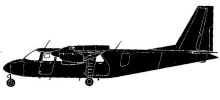
| Date: | Tuesday 6 April 1993 |
| Time: | 15:47 |
| Type: |  Britten-Norman BN-2A-26 Islander |
| Owner/operator: | Great Barrier Airlines (New Zealand) |
| Registration: | ZK-FVD |
| MSN: | 316 |
| Year of manufacture: | 1973 |
| Engine model: | Lycoming O-540-E4C5 |
| Fatalities: | Fatalities: 0 / Occupants: 6 |
| Aircraft damage: | Substantial, repaired |
| Category: | Accident |
| Location: | Great Barrier Island Airport (GBZ) -
 New Zealand New Zealand
|
| Phase: | Landing |
| Nature: | Passenger - Scheduled |
| Departure airport: | Auckland International Airport (AKL/NZAA) |
| Great Barrier Island Airport (GBZ/NZGB) | |
| Investigating agency: | TAIC |
| Confidence Rating: |
A Britten-Norman BN-2A Islander passenger plane sustained substantial damage in a landing accident at Great Barrier Island Airport (GBZ), New Zealand. The six occupants were not injured.
ZK-FVD, operated by Great Barrier Airlines, was being flown on a scheduled passenger service (flight GB 1) between Auckland International Airport and Great Barrier (Claris) Aerodrome.
Prior to descent, the pilot checked the brakes and found that the left brake pedal was "soft"; pumping the brake pedal did not restore it to normal. No abnormality had been noticed during taxiing at Auckland. The pilot briefly considered the possibility of returning to Auckland (where the problem could have been rectified), but decided that this was unnecessary and that a landing could be accomplished safely at Great Barrier. However, the possibility of a rejected takeoff on departure from Great Barrier, requiring serviceable brakes, was not considered.
The runways available at Great Barrier were 06/24, with a total length of 620 m, and 10/28, with a total
length of 930 m. On runways 06 and 10 there were displaced landing thresholds of 22 m and 60 m respectively.
Arriving in the circuit area at Great Barrier, the pilot carried out a standard circuit joining procedure, and observing the wind to be blowing from about 190 degrees magnetic at less than 10 knots, elected to use runway 10.
The pilot stated that she chose runway 10 because the location of the aircraft parking area in relation to the runway would require only right-hand turns during taxiing, minimising the need for use of the left brake.
However, ZK-FVD was equipped with nosewheel steering and this, combined with the use of asymmetric power during ground manoeuvring, should have allowed the pilot to taxi without difficulty.
The pilot made a normal approach, but was aiming to utilise the maximum runway length, including that prior to the 60 m displaced landing threshold on this runway. As she flared the aircraft for touchdown, she felt a solid bump, "like a heavy landing".
Both pairs of main undercarriage wheels had contacted the lip of the drainage ditch at the runway threshold, tearing the left leg from its attachment points and damaging the right one substantially.
As the aircraft lost flying speed, it settled onto its belly and left wingtip, and began to veer towards the left side of the strip. The pilot attempted to maintain directional control using right rudder and brake, but without success. The aircraft came to rest in the manuka scrub beside the strip, 260 m from the point of first ground contact.
FINDINGS:
1 The pilot was appropriately licensed and experienced for the flight.
2 With the exception of a suspected brake problem, the aircraft was airworthy and operating normally prior to the accident.
3 In attempting to utilise the maximum landing distance, the pilot undershot the runway, and the aircraft struck the lip of the perimeter drain with both undercarriage legs.
4 The pilot may have been distracted by consideration of the effects of a brake problem.
5 The cause of the brake problem was not established.
6 The pilot's decision to land at Great Barrier Aerodrome should not, of itself, have jeopardised the safety of the passengers unnecessarily.
7 It would have been more appropriate for the pilot to have returned to an aerodrome with a maintenance facility than to continue the flight to a remote location with no such facility.
Accident investigation:
 |
|
Sources:
Revision history:
| Date/time | Contributor | Updates |
|---|
The Aviation Safety Network is an exclusive service provided by:


 ©2024 Flight Safety Foundation
©2024 Flight Safety Foundation